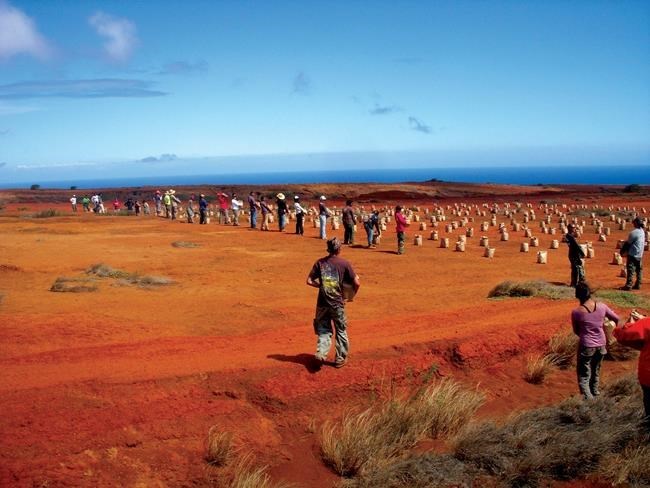
In this 2010 photo provided by the Kahoolawe Island Reserve Commission, volunteers work the hardpan at the Hakioawa Watershed on Kahoolawe, Hawaii. In World War II, the U.S. Navy started using the 45 square miles of Kahoolawe as a bombing range. After two decades of trying to restore a Hawaiian island ravaged by nearly 50 years of military bombing, its future funding is now in jeopardy. The Kahoolawe Island Reserve Commission, which is the agency tasked with restoring the island, has yet to be funded after 2017. (Mike Nahoopii/Kahoolawe Island Reserve Commission via AP)
June 02, 2016 - 6:31 AM
HONOLULU - Six miles from the scenic beaches of south Maui sits a small, deserted island with a rich history and a big problem.
Researchers say Hawaiians travelled to Kahoolawe Island as early as 400 A.D., and it's home to nearly 3,000 archaeological sites. It's also littered with unexploded ordnance.
The U.S. Navy used the barren island as a bombing range for decades starting in World War II. It later joined with the state and spent millions on cleanup, but they didn't finish the job.
Today, live grenades and bombs remain scattered across about a quarter of the 45-square-mile island. But the agency tasked with restoring Kahoolawe is likely on its own next year after lawmakers passed a bill pushing it to become financially self-sufficient.
Now, the Kahoolawe Island Reserve Commission and community advocates are looking for ways to fund the rest of the cleanup so they can bring back native wildlife and use the island as a Native Hawaiian educational centre.
It's no small effort. Restoring and then replanting the entire island could take decades and cost billions of dollars, despite about $400 million spent between the commission and the Navy since 1994, the agency said. The commission also has depleted a $44 million federal trust fund since the state gained control of the island in 2004.
"It speaks volumes to the amount of bombing Kahoolawe sustained that so much work still needs to be done to complete this effort," U.S. Sen. Mazie Hirono said. She added she will work to help find solutions to finish the cleanup at the culturally significant site, which is banned from commercial use.
On a clear day, the islands of Maui, Lanai and Molokai are visible from the shores of Kahoolawe, which archaeological evidence suggests Hawaiians used as a navigational centre for voyaging, a workshop for making stone tools and for cultural ceremonies. Fortunately, many of the cultural sites such as fishing shrines were on the coast and were spared from the military bombing, which went on for 50 years, said Michael Nahoopii, the Kahoolawe Island Reserve Commission's executive director.
Still, gold-colored grenades that explode if touched, bombs weighing up to 2,000 pounds and hundreds of projectiles remain.
"You walk across this line, and it is night and day. One side of the line is very clean. There's no scrap metal. There's nothing on the ground," Nahoopii said. "You walk across this line, and there's bombs sticking out of the ground. There are pieces of razor-sharp metal."
A 2013 financial audit criticized the Kahoolawe commission for lacking a comprehensive cleanup plan and measures to gauge if objectives are being met.
Lawmakers recently passed a measure giving the agency $450,000 for restoration during the upcoming year, but no money after 2017. One of the requirements is that the commission come up with a plan for being self-sufficient. The proposal has been sent to Gov. David Ige, who hasn't said whether he will sign it into law.
Ideas for future funding include running the island off renewable energy and charging tuition for educational programs.
Josh Kaakua, a commissioner and member of the Protect Kahoolawe Ohana, said the state should help fund Kahoolawe's restoration since it took responsibility for the island after the Navy ended the federal cleanup.
The island was also ravaged by years of cattle and goat ranching before its military use — the Army first trained there in 1925 — and faces problems with severe erosion and a lack of fresh water sources.
"I think people only care about what's in their backyard, so often I think Kahoolawe gets put to the side," Kaakua said. "Kahoolawe is a treasure. It's a resource. But we're losing it. We're slipping. Nobody is paying attention."
Nahoopii, meanwhile, said the Navy has a responsibility to finish restoring the island. When the federal government took over Kahoolawe in the 1950s, it agreed to return the land in a condition of "suitable habitation," he said.
Yet Agnes Tauyan, director of public affairs for Navy Region Hawaii, said the Navy completed what was required by the federal government and isn't aware of any requests to return to Kahoolawe.
Kahoolawe is one of about 100 formerly used defence sites throughout the Pacific, according to the U.S. Army Corps of Engineers Honolulu District. Right now, the U.S. Army Corps of Engineers Honolulu District is working on about 10 cleanup projects, including the Waikoloa Maneuver Area on the Big Island, which alone is expected to cost about $723 million to clean up.
"It's really a microcosm of what's happening in the whole world, right on Kahoolawe," Nahoopii said.
News from © The Associated Press, 2016